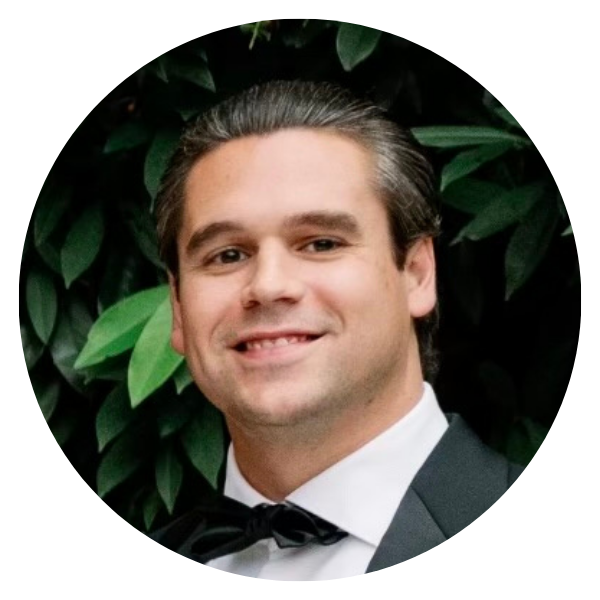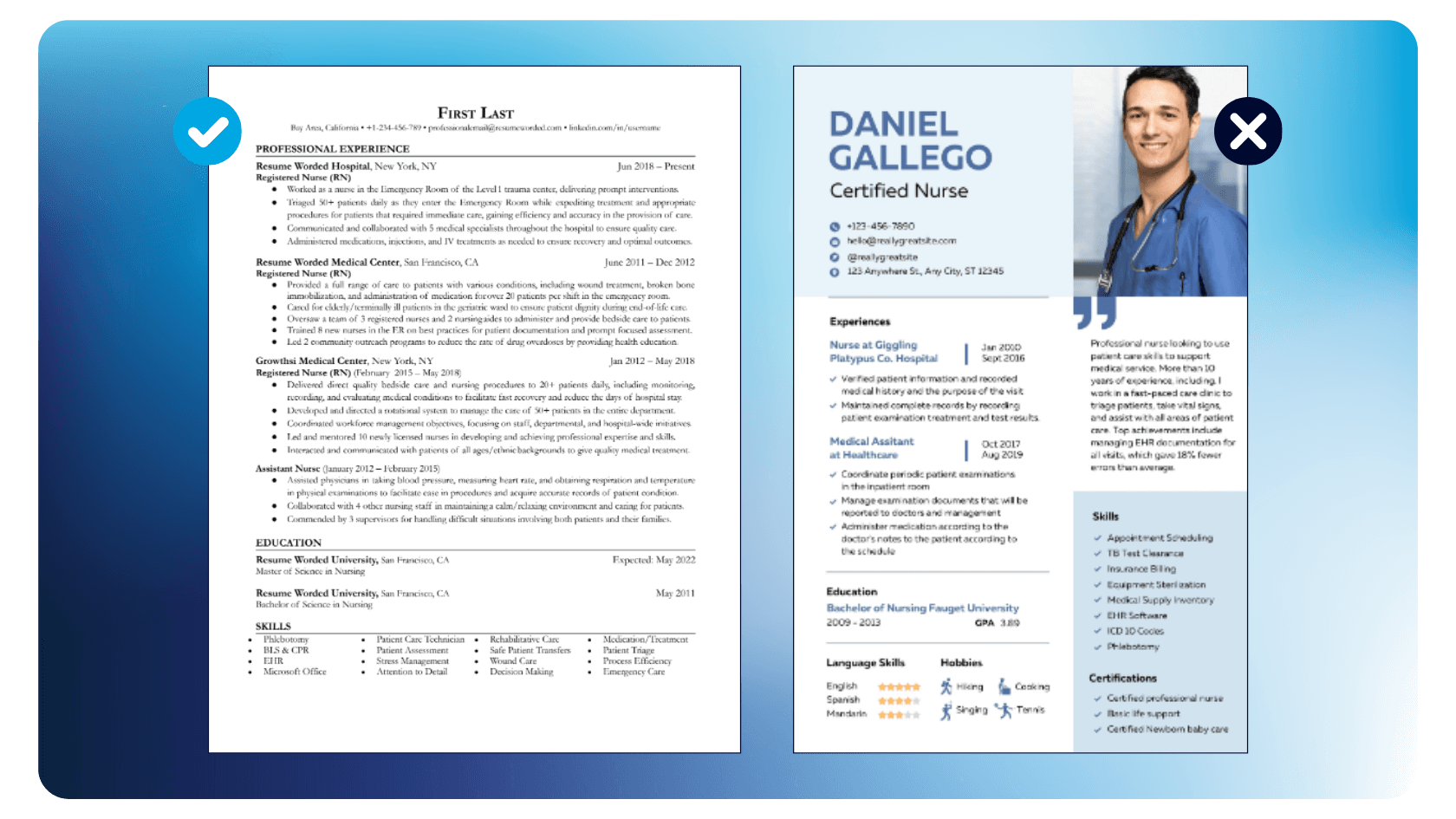
How to Write a Healthcare Resume That Stands Out in 2025
February 9, 2025
In today's fiercely competitive job market, where Applicant Tracking Systems (ATS) and resume parsing technologies reign supreme, standing out from the crowd has become more challenging than ever. However, it's not just about navigating these digital gatekeepers— impressing recruiters and hiring managers is still a crucial part of the process.
What are Applicant Tracking Systems (ATS)?
Often referred to as automated tracking or talent management systems, ATS are software applications used by employers to manage the recruitment and hiring process. They streamline the process by automating tasks like:
- Collecting and storing resumes and applications
- Scanning and sorting candidates based on keywords and criteria
- Scheduling interviews and sending notifications
- Tracking the progress of candidates through the hiring pipeline
These systems help employers save time and resources while identifying the most qualified candidates for their open positions.
We chatted with Ryan Kronberger, a Senior Recruiter on the GHR team, to discuss how mastering certain resume elements can not only help you bypass ATS but also leave a lasting impression on those responsible for making hiring decisions.

Ryan: “There was a study conducted in 2018 using eye-tracking technology that found on average, hiring managers spend just 7.4 seconds reviewing candidates’ resumes. This illustrates the importance of optimizing your resume such that it is easy to read and comprehend quickly. This may seem obvious, but the number of resumes we see with poor formatting and missing information is astounding. This runs the gamut from staff-level employees to executive leadership. Assume you have 10 seconds to catch the reader’s eye.”
How to Write a Healthcare Resume: 6 Tips
Whether you're a seasoned professional or just starting your career, your resume is often the first impression you make on potential employers. It needs to showcase your skills, experience, and dedication to patient care in a way that sets you apart from other candidates. Below are Ryan's essential tips and strategies to help you create a healthcare resume that stands out, highlighting your unique qualifications and making you an irresistible choice for recruiters.
1. Keep the Formatting Simple
When it comes to formatting your resume, simplicity is key. While it's tempting to use fancy fonts, graphics, or elaborate designs to stand out, such elements can often backfire, especially when parsed by ATS. Stick to clean, easy-to-read fonts like Arial, Calibri, or Times New Roman, and use a consistent font size throughout the document. Organize your content into clearly defined sections, such as "Professional Experience," "Education," and "Skills," with bullet points for easy scanning.
Avoid excessive use of formatting features like bold, italics, or underlining, as these can disrupt ATS parsing and make your resume appear cluttered. Instead, use them sparingly to emphasize key points or section headings. Ensure sufficient white space between sections to improve readability and create a professional-looking layout.
Note: PDF resumes with complex formatting and multiple columns are not ATS-friendly!
The image below shares an example of a healthcare resume that is simple and well-formatted, and compares it against a resume that is more likely to disrupt ATS parsing.

By keeping the formatting simple and streamlined, you not only enhance the readability of your resume for both ATS and human reviewers but also demonstrate your professionalism and attention to detail—a quality that recruiters and hiring managers value highly.

Ryan: “PDF resumes make me wince. I understand the allure, but this file format often does more harm than good. The PDF is an invention of Adobe. They still hold a patent. Anyone can create a PDF file, but it can only be edited using Adobe software. Recruiters will often catch grammatical, spelling, or formatting errors and correct them before forwarding your resume over to the hiring manager. It is time-consuming to make even the smallest alteration to a PDF. Candidates are often unable to edit their own resumes! Most enterprises use the Microsoft Office Suite. It does not make sense to use a file format that is not part of that ecosystem. Word Documents are superior in almost all cases.”
2. Maintain Clear Job Titles and Licenses
Maintaining clear and standardized job titles and licenses is one of the first steps to ensure your resume makes it through the initial ATS screening process. While it might be tempting to get creative with your job titles, especially in fields like healthcare where roles can vary, sticking to industry-standard terms increases the likelihood of your resume matching the job description. For instance, instead of using obscure acronyms or internal titles, opt for clear and universally recognized terms such as Registered Nurse (RN), Licensed Practical Nurse (LPN), or Nurse Practitioner (NP).

Ryan: “It has become exceedingly common (much to my chagrin) that candidates omit job titles altogether. They include the names of their employers or the clinical setting but assume the reader knows what they did there. We should be able to tell immediately if you are an RN or an MD. The person reading your resume should not have to embark on a scavenger hunt to determine this. It is likely that they simply move on to the next resume and you are never considered.”
3. Include Keywords from the Job Description
In the world of ATS, keywords are king. These systems scan resumes for specific keywords and phrases that match the job description. Therefore, it’s best to carefully analyze the job posting and incorporate relevant keywords into your resume. Whether it's clinical skills, certifications, or specific software proficiencies, aligning your resume with the job requirements increases your chances of making it past the initial screening.
Applying to multiple jobs can be demanding. If creating a new resume for each application feels overwhelming, consider creating multiple versions tailored to different skill sets and keyword variations. Save them with descriptive file names that reflect the targeted roles, making it easier to manage and switch between versions. Remember, while keywords are important, avoid stuffing your resume with them. Focus on presenting your qualifications in a clear, concise, and human-readable manner. This ensures your resume effectively passes both the ATS and human review stages.

Ryan: “If you are applying to a position that requires niche experience, it needs to be called out on your resume. Take palliative care, for example. We interviewed a provider recently with extensive palliative care experience but did not mention it once on their resume. When asked why, they assumed this experience was implied based on where they had worked. Never expect that the person reviewing your resume is going to read between the lines. Websites are designed for Search Engine Optimization so that they appear on the first page of Google. You should optimize your resume in the same way. Use the keywords and phrases that relate to the work you have done.”
Which leads us to…
4. Tailor Your Resume for Each Job and Employer
Gone are the days of sending out generic resumes en masse. To truly stand out, tailor your resume for each job and employer you apply to. Customize your resume to highlight the skills, experiences, and achievements most relevant to the position. Research the company culture and values, and adjust your resume to reflect how your background aligns with their mission. Employers appreciate candidates who take the time to understand their organization and demonstrate a genuine interest in the role.

Ryan: “Tailoring your resume’s ‘cold open’ can be surprisingly effective. Keep it short and sweet. Tell the person reading your resume in a few sentences why you are a fit. If you lack some of the experience called out in the job description, this is your opportunity to overcome this by highlighting why the experience you do have will make for a limited learning curve. This extra bit of color may be enough to convince the hiring manager that you are worth speaking to.”
5. Use Powerful Words and Give Evidence
When describing your experiences and accomplishments, use powerful action verbs to convey your contributions effectively. Words like "implemented," "streamlined," or "achieved" carry more weight than passive phrases. Furthermore, back up your claims with concrete evidence whenever possible. Quantify your achievements with numbers, percentages, or other measurable metrics to demonstrate the impact you've made in previous roles.
Example:
- Instead of saying: "Assisted with patient care."
- Say: "Provided exceptional patient care to an average of 20+ individuals per shift, maintaining a satisfaction rating of 95%."

Ryan: “Highlighting and quantifying accomplishments is important at all levels, but especially for candidates who work in management or executive leadership. Good leaders do not simply keep the train on the tracks. They make improvements, mentor their subordinates, and ultimately leave the organization better than they found it. Your accomplishments are feathers in your cap. Wear them proudly. Give specific examples. Toot your own horn!”
6. Proofread, Proofread, Proofread!
Before submitting your resume, ensure it's free of typos, grammatical errors, and formatting inconsistencies. Even the smallest mistake can detract from your professionalism and attention to detail. Ask a trusted friend, family member, or professional colleague to review your resume for a fresh perspective. Taking the extra time to polish your resume demonstrates your commitment to excellence and sets you apart from the competition.
In a job market inundated with applicants, mastering the art of resume crafting is essential for healthcare professionals aiming to stand out. By maintaining clear job titles, incorporating relevant keywords, tailoring your resume for each opportunity, using powerful language backed by evidence, and meticulously proofreading your document, you can increase your chances of catching the attention of hiring managers and securing the job of your dreams. Remember, your resume is your first impression—make it count.
Learn more about resume optimizations with our physical therapist resume guide.
Ready to send your new resume & get matched with jobs perfect for you?

Ryan Kronberger
Senior Recruiter, Direct Placement | GHR Healthcare
Ryan began his career as a Recruiter in 2010. His experience was focused on Information Technology until 2021 when he joined GHR and transitioned to Healthcare. Ryan is a Sr. Recruiter on GHR’s Direct Placement team where he specializes in placing clinicians and executive leadership
Search, manage, and apply to healthcare jobs across the US.
With GHRLive!, your career is in your hands. Literally.
Articles & Free Resources
Subscribe to GHR's Blog Newsletter
Your submission was successful.
Thank you for subscribing — we'll be in touch!





